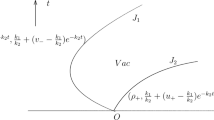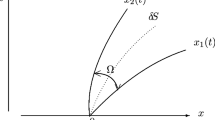Abstract
We establish the equivalence of free piston and delta shock, for the one-space-dimensional pressureless compressible Euler equations. The delta shock appearing in the singular Riemann problem is exactly the piston that may move freely forward or backward in a straight tube, driven by the pressureless Euler flows on two sides of it in the tube. This result not only helps to understand the physics of the somewhat mysterious delta shocks, but also provides a way to reduce the fluid–solid interaction problem, which consists of several initial-boundary value problems coupled with moving boundaries, to a simpler Cauchy problem. We show the equivalence from three different perspectives. The first one is from the sticky particles, and derives the ordinary differential equation (ODE) of the trajectory of the piston by a straightforward application of conservation law of momentum, which is physically simple and clear. The second one is to study a coupled initial-boundary value problem of pressureless Euler equations, with the piston as a moving boundary following the Newton’s second law. It depends on a concept of Radon measure solutions of initial-boundary value problems of the compressible Euler equations which enables us to calculate the force on the piston given by the flow. The last one is to solve directly the singular Riemann problem and obtain the ODE of delta shock by the generalized Rankine–Hugoniot conditions. All the three methods lead to the same ODE.
Similar content being viewed by others
References
Bouchut, F.: On zero pressure gas dynamics. In: Advances in Kinetic Theory and Computing, volume 22 of Ser. Adv. Math. Appl. Sci., pp. 171–190. World Scientific Publishing, River Edge (1994)
Chen, G.Q., Chen, S.X., Wang, D.H., Wang, Z.J.: A multidimensional piston problem for the Euler equations for compressible flow. Discrete Contin. Dyn. Syst. 13, 361–383 (2005)
Chen, G.Q., Liu, H.L.: Formation of $\delta $-shocks and vacuum states in the vanishing pressure limit of solutions to the Euler equations for isentropic fluids. SIAM J. Math. Anal. 34, 925–938 (2003)
Chen, S.X., Qu, A.F.: Piston problems of two-dimensional Chaplygin gas. Chin. Ann. Math. Ser. B. 40, 843–868 (2019)
Chen, S.X., Wang, Z.J., Zhang, Y.Q.: Global existence of shock front solution to axially symmetric piston problem in compressible flow. Z. Angew. Math. Phys. 59, 434–456 (2008)
Cheng, S.Z., Li, J.Q., Zhang, T.: Explicit construction of measure solutions of Cauchy problem for transportation equations. Sci. China Ser. A 40, 1287–1299 (1997)
Courant, R., Friedrichs, K.O.: Supersonic flow and shock waves. Springer (1976). Reprinting of the 1948 original, Applied Mathematical Sciences. 21
Huang, F.M., Wang, Z.: Well posedness for pressureless flow. Commun. Math. Phys. 222, 117–146 (2001)
Jin, Y.J., Qu, A.F., Yuan, H.R.: Radon measure solutions for steady compressible hypersonic-limit Euler flows passing cylindrically symmetric conical bodies. Commun. Pure Appl. Anal. 20, 2665–2685 (2021)
Jin, Y.J., Qu, A.F., Yuan, H.R.: On two-dimensional steady hypersonic-limit Euler flows passing ramps and Radon measure solutions of compressible Euler equations. Commun. Math. Sci. arXiv:1909.03624 (2019)
Jin, Y.J., Qu, A.F., Yuan, H.R.: Radon measure solutions of Riemann problem of isentropic compressible Euler equations of polytropic gases. Commun. Appl. Math. Comput (2022)
Li, J.Q.: Note on the compressible Euler equations with zero temperature. Appl. Math. Lett. 14, 519–523 (2001)
Li, J.Q., Warnecke, G.: Generalized characteristics and the uniqueness of entropy solutions to zero-pressure gas dynamics. Adv. Differ. Equ. 8, 961–1004 (2003)
Li, J.Q., Zhang, T.: The dominator of compressible Euler equations. In: Nonlinear Evolution Equations and Their Applications (Macau), pp. 116–127. World Scientific Publishing, River Edge (1998)
Li, J.Q., Zhang, T., Yang, S.L.: The Two-Dimensional Riemann Problem in Gas Dynamics. Pitman Monographs and Surveys in Pure and Applied Mathematics, 98. Longman, Harlow (1998)
Liu, T.P.: The free piston problem for gas dynamics. J. Differ. Equ. 30, 175–191 (1978)
Qu, A.F., Yuan, H.R.: Measure solutions of one-dimensional piston problem for compressible Euler equations of Chaplygin gas. J. Math. Anal. Appl. 481, 123486 (2020)
Qu, A.F., Yuan, H.R.: Radon measure solutions for steady compressible Euler equations of hypersonic-limit conical flows and Newton’s sine-squared law. J. Differ. Equ. 269, 495–522 (2020)
Qu, A.F., Wang, L., Yuan, H.R.: Radon measure solutions for steady hypersonic-limit Euler flows passing two-dimensional finite non-symmetric obstacles and interactions of free concentration layers. Commun. Math. Sci. 19, 875–901 (2021)
Qu, A.F., Yuan, H.R., Zhao, Q.: High Mach number limit of one-dimensional piston problem for non-isentropic compressible Euler equations: polytropic gas. J. Math. Phys. 61, 011507 (2020)
Qu, A.F., Yuan, H.R., Zhao, Q.: Hypersonic limit of two-dimensional steady compressible Euler flows passing a straight wedge. ZAMM Z. Angew. Math. Mech. 100, e201800225 (2020)
Sheng, W.C., Zhang, T.: The Riemann problem for the transportation equations in gas dynamics. Mem. Am. Math. Soc. 137, viii+77 (1999)
Tan, D.C., Zhang, T.: Two-dimensional Riemann problem for a hyperbolic system of nonlinear conservation laws. I. Four-$J$ cases. J. Differ. Equ. 111, 203–254 (1994)
Weinan, E., Rykov, Y.G., Sinai, Y.G.: Generalized variational principles, global weak solutions and behavior with random initial data for systems of conservation laws arising in adhesion particle dynamics. Commun. Math. Phys. 177, 349–380 (1996)
Yang, H.C., Zhang, Y.Y.: New developments of delta shock waves and its applications in systems of conservation laws. J. Differ. Equ. 252, 5951–5993 (2012)
Acknowledgements
The authors are grateful to Professor Jiequan Li, for pointing out the connection between delta shock and free piston problem in a private communication, which consists the main contribution of this manuscript. He also gave us valuable and detailed suggestions and corrections on an earlier draft. We thank him sincerely for his generosity and encouragements!
Author information
Authors and Affiliations
Corresponding author
Additional information
Publisher's Note
Springer Nature remains neutral with regard to jurisdictional claims in published maps and institutional affiliations.
This work is supported by the National Natural Science Foundation of China under Grants Nos. 11871218, 12071298, and by the Science and Technology Commission of Shanghai Municipality under Grant No. 18dz2271000.
Appendix A: Solvability of piston’s trajectories
Appendix A: Solvability of piston’s trajectories
For convenience of readers, in this “Appendix”, we list the results on the six cases of the free piston problem. We omit the proof, since the details are the same as those in [15, pp. 67–72].
1.1 Appendix A.1: Case 1: \(u_2<u_0<u_{1}\)
Theorem 4
Suppose that \(u_2<u_0<u_{1}\), then the free piston problem (1)–(5) admits a global solution, in which the trajectory of the piston satisfies (14). The velocity of the piston \(x'_ {1}(t)\in (u_2,u_1)\) for any \(t>0\), and it converges to a constant as \(t\rightarrow +\infty \). There are concentration on both sides of the piston for all the time. Particularly, we have
(1) If \(\rho _{1}\ne \rho _{2}\),
(2) If \(\rho _{1}=\rho _{2}\),
1.2 Appendix A.2: Cases 2 and 3: \(u_{1}>u_0\), \(u_{2}>u_0\)
For Case 3, we know the physical picture is as follows: there is a moment \(t_1\), such that if \(0< t<t_1\), there is a vacuum near the right side of the piston; as the flow on the left accelerates, the piston, it chases the constant moving flow \(U_2=(\rho _2,u_2)^\top \) on the right, and at \(t_1\) the piston meets \(U_2\) and then concentration on the right side of the piston occurs; what happens next is the same as in Case 1. For Case 2, the story is a little bit different: the piston could never catch up with the right state \(U_2\), and there is always vacuum near its right side. The following theorem verifies this.
Theorem 5
For the free piston problem (1)–(5), suppose that \(u_{1}>u_0\), \(u_{2}>u_0\), then it admits a global solution.
More specifically, for Case 2: \(u_0<u_{1}<u_{2}\), there is always vacuum near the right surface of the piston, namely the piston will never catch up with the right-side moving flows with state \((\rho _2, u_2)^{\top }\), and the trajectory of the left surface of the piston is
The limiting velocity of the piston is
For Case 3: \(u_0<u_{2}<u_{1}\), \(x_1(t)\) is given by
where \(\displaystyle t_1\doteq \frac{2m_0(u_2-u_0)}{\rho _1(u_1-u_2)^2}\), and \(\tilde{x}_1(\cdot )\) is the function given by (38) if \(\rho _1\ne \rho _2\), and by (41) if \(\rho _1= \rho _2\), while in both of which, \(m_0\) is replaced by \(\alpha (t_1)\) defined in (36) and \(u_0\) is replaced by \(\displaystyle \frac{2u_1u_2-u_0u_2-u_0u_1}{u_1+u_2-2u_0}\). The limiting velocity of the piston is given by (40) and (42), respectively.
1.3 Appendix A.3: The other cases
As discussed in Sect. 2.3, Case 4 and Case 5 (\(u_{1}<u_0\), \(u_{2}<u_0\)) are in essence the same as Cases 2 and 3 studied above. So we will not repeat the results any more. For the last Case 6, namely \(u_{1}\le u_0\le u_{2}\), the pressureless gas moves uniformly away from the piston, and there are vacuum near the piston and the piston’s trajectory is given by \(x_1(t)=u_0t,\ \forall \, t\ge 0\). The solution for this case is trivial.
Rights and permissions
About this article
Cite this article
Gao, L., Qu, A. & Yuan, H. Delta shock as free piston in pressureless Euler flows. Z. Angew. Math. Phys. 73, 114 (2022). https://doi.org/10.1007/s00033-022-01754-4
Received:
Revised:
Accepted:
Published:
DOI: https://doi.org/10.1007/s00033-022-01754-4




